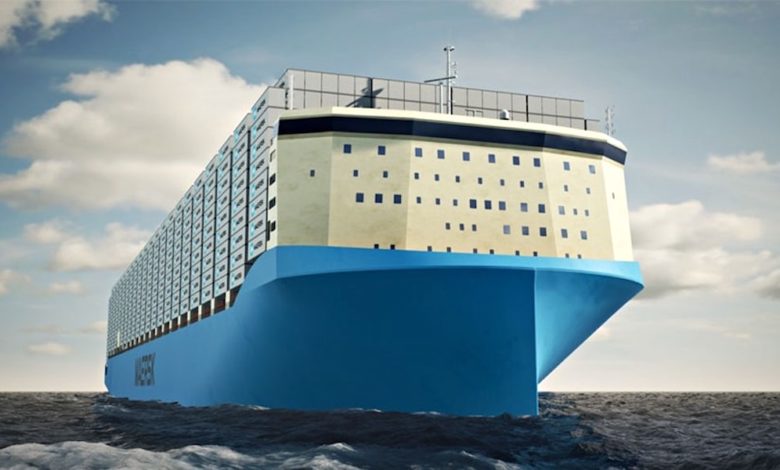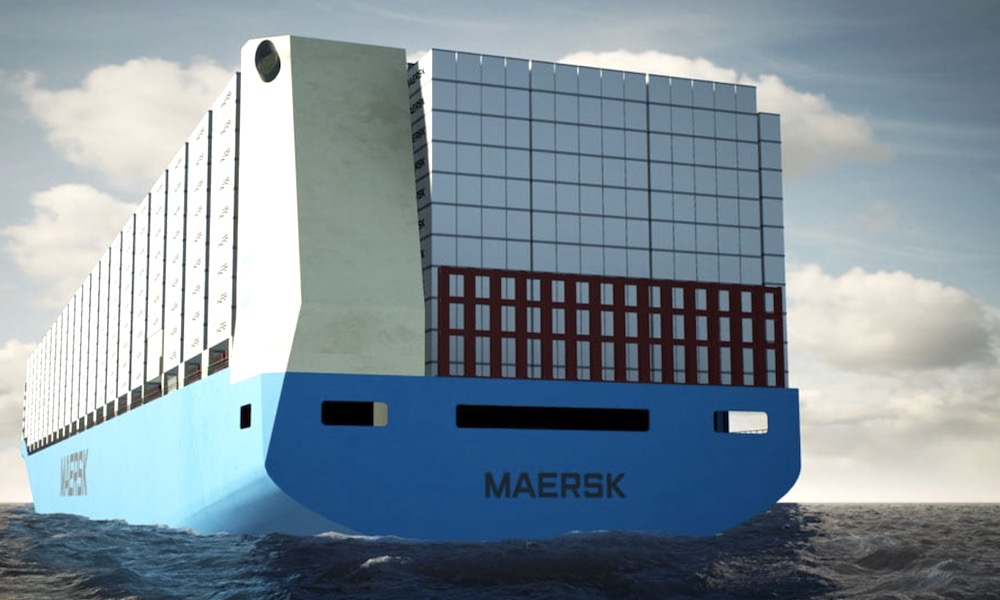Maersk unveils revolutionary new boxship design

Looking more like a livestock carrier than a boxship, Maersk yesterday unveiled its brand new design for its next generation of green ships.
Intended to sail on green methanol with 16,000 teu of capacity, 350 m in length and a new look for container vessels, Maersk’s groundbreaking new series of eight ships will deliver from Hyundai Heavy Industries in 2024.
The design allows a 20% improved energy efficiency per transported container, when comparing to the industry average for vessels in this size, Maersk claimed yesterday. Additionally, the entire series is expected to save around 1m tons of annual CO2 emissions, offering customers carbon-neutral transportation at scale on ocean trades.

The crew accommodation and bridge will be located at the bow to enable increased container capacity.
New arrangements for lifeboats and navigational lights have been developed, plus new cameras to support the captain’s view when navigating.
The funnel will be in the aft, and only on one side of the vessel, thereby providing further space for cargo. This separation between accommodation and funnel will improve efficiency when at the port, Maersk suggested.
The series, classed by ABS, comes with a dual-fuel engine setup that can operate on methanol and conventional low-sulphur fuel.
As well as the eight 16,000 teu ships, Maersk also has a 2,000 teu feeder vessel under construction, which will run on methanol too.
Maersk has a history of introducing groundbreaking ship designs into the liner trades, such as its orders a decade ago for its EEE class of ships, ushering in the supersized, 18,000+ teu era of container shipping.

Sorry to burst your bubble guys … but there is nothing really that “groundbreaking” here, relative to the deck house/cargo layout. US flag ships have had house forward ships for decades. Look at the C-9 class ships being operated today by Matson, which were originally built 40+ years ago by APL (back when APL was an American company). The C-9 class was an improvement over the C-8s (older steam ships, with a house forward) and bigger in size and capacity.
Horizon Lines still has one house forward ship class operating, the HORIZON SPIRIT and her sister, the RELIANCE. These two ships are also, older steam ships, house forward, 273 meters LOA. One ship is currently running in the USWC to Hawaii trade. The other is being converted to a diesel ship with LNG fuel. Her hull is still solid after 40+ years, a conversion was cheaper than building new.
I’m amused at Maersk’s effort to pat themselves on the back for such groundbreaking ideas (not). Her fuel selection might be new. But Naval architects have opted to place the typical container ship house back aft over the engine space in an effort to maximize cargo space for years. US designers put the deck house on the bow years ago and it really was a new idea back then. Those ships continue to operate still today and i have been piloting them for 27+ years.
A house forward has its own issues, especially in heavy weather. The crews will enjoy the pitching in head seas! And pilots will have to get used to the challenge of driving with nothing in front of you to visually gauge your swing/ROT. We do it all the time, especially on cruise ships and auto carriers. But the size of these box ships will make it more challenging.
Pitching😅 not bad at all on this one.
Ed – good points – out of interest – where’s the funnels for these Matson and Horizon ships?
Back aft, about 3/4 way aft from the bow. Much like we see today on the mega ship designs. The ‘stack’ takes up a space fore/aft that is roughly equivalent no more than a slot for a forty foot box. All the fans, blowers, etc are in this same “box” on deck.
Cool!!! Gives the bridge crew better view of over the bow.👍
It’s always amazing to see how narrowly people are thinking. The new design is about reducing emission and increasing efficiency. That’s something, which never bothered the US carriers.
Personally, I don’t like the design with the bridge right on the bow, but it’s ok if your ship is autonomous and operating without crew – probably a feature which will be announced at a later stage.
Yea … you know how we Americans are so “narrow minded” aren’t we?
( Merry Christmas! )
Looks very smart.As a former engineer the guys have their exersize 😅
A nice modern vessel this is.
When i say nice,nothing nicer then 60 70s vessels of course.World is changing
Great – now all you need are tugs powerful enough to manage the wind effects – great windage area!! Good luck berthing her with gusts, oh hold on they can just wait till weather gets better.
Absolutely genius!!!
Interesting that they left out the lifeboat in the design😂 as Capt. Ed Enos pointed out such fwd accommodation is very common in car carriers and US coastal ships for decades now. Change of fuel though is a good choice and must be appreciated
There are similar container vessels.
https://www.marinetraffic.com/en/ais/details/ships/shipid:5595295/mmsi:431011592/imo:9843778/vessel:NAGARA/_:e869a648411a319b6f378fcb22184b5b
https://www.marinetraffic.com/en/ais/details/ships/shipid:3727868/mmsi:431007132/imo:9729788/vessel:NATORI
The crew will get no sleep when the bow is slamming into big waves.
But great view
Is this yet another class that clear the canals?
Green methanol. So, how is that produced then? I thought co2 was the gaseoes emission of brewing? And co2 is a significant emission of its combustion.